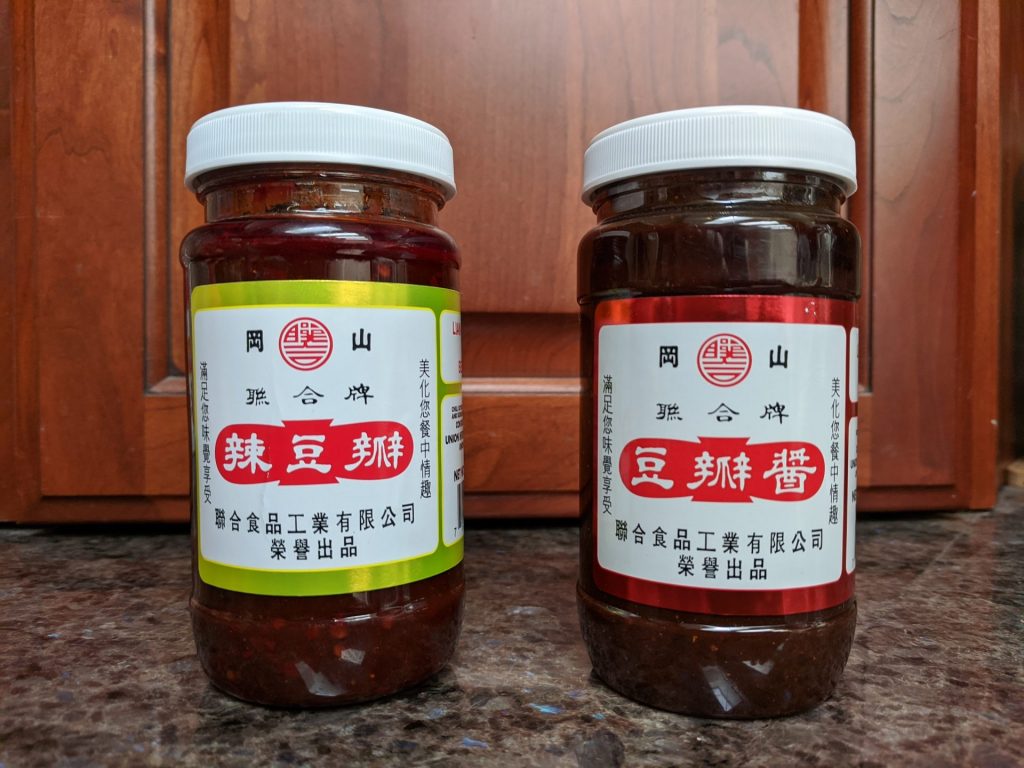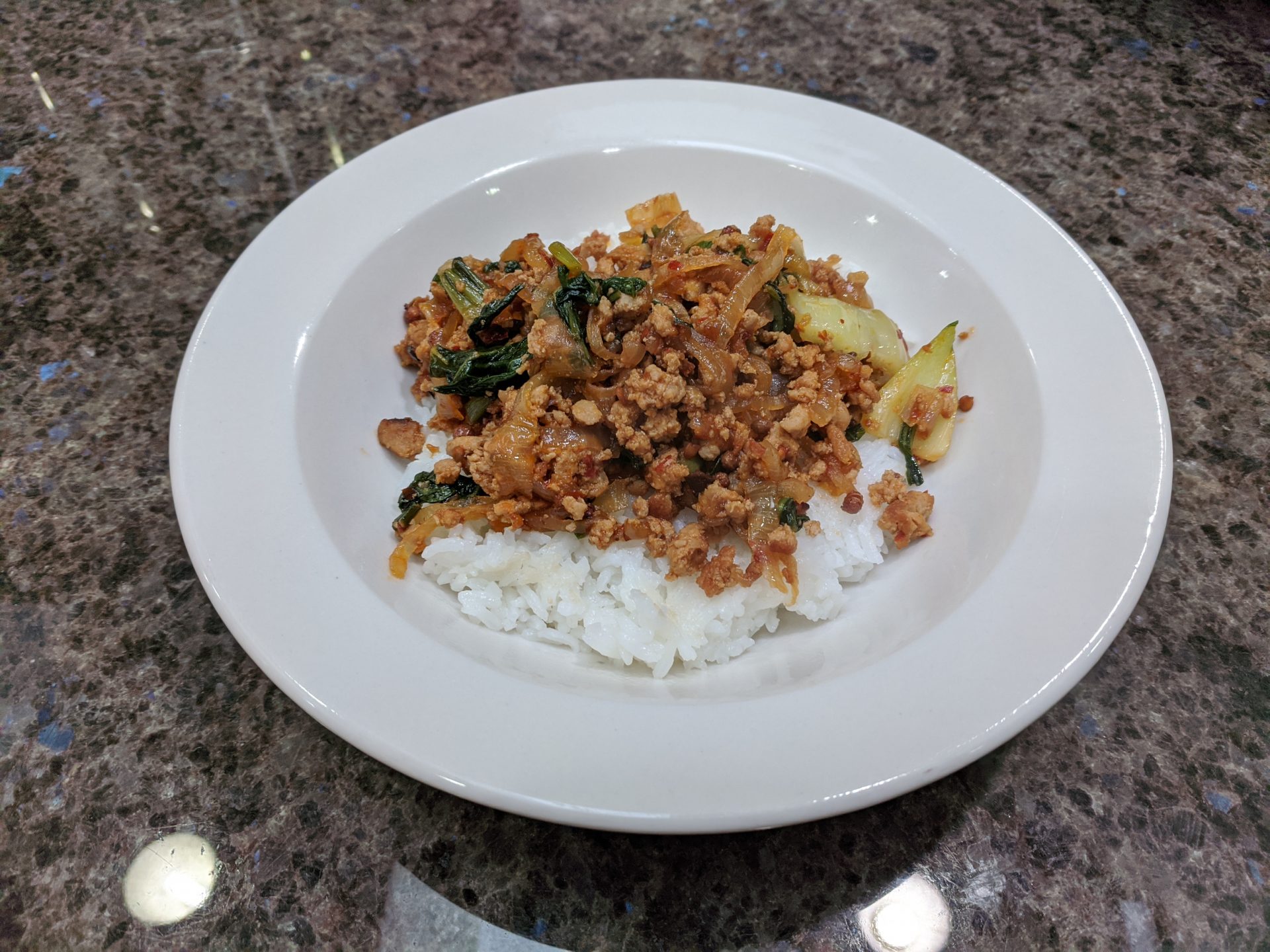This recipe is from Lucky Peach Presents 101 Easy Asian Recipes, where it’s described as “This bastard love child of Bolognese and mapo tofu is a de-escalated and simplified version of a dish from Momofuku Ssam bar. You will Win Friends and Influence People by serving it in your home.”
It’s as delicious as advertised. I suggest some minor changes in my notes to make a non-spicy version for kids or others who can’t tolerate spicy food. It keeps the same flavor profile from the bean paste, but tastes sweeter after removing the heat and numbing sensation.
Momofuku: A Cookbook has the previous “escalated” recipe under “spicy pork sausage & rice cakes, chinese broccoli & crispy shallots.” I’ve included it at the end for comparison.
Ingredients
- 2 T neutral oil
- 2 large yellow onions, halved and thinly sliced (about 5 C)
- 1 lb ground pork
- 1 T chopped garlic
- 2 T doubanjiang or gochujang (spicy chili-bean paste)
- 1 T Sichuan peppercorns
- 1 t chili flakes (preferably gochugaru)
- 1 T soy sauce
- 1 T sugar
- 1/4 C water
- 2 C coarsely chopped bok choy
- Cooked fresh wheat noodles (lo mein or ramen), rice noodles, spaghetti, or rice if that’s what you feel like having
- Thinly sliced scallions for garnish
Instructions
- Heat 1 tablespoon oil in a 3-quart saucepan (or a wide deep skillet) over medium heat. Add the onions and cook, stirring and folding, until the onions are light golden but still retain their shape, about 15 minutes. Scoop the onions onto a plate and wipe out the skillet with a towel.
- Heat the remaining 1 tablespoon oil in the pan, then add the ground pork and cook, breaking the meat into small pieces with a spoon, until just cooked through, about 8 minutes.
- Push the meat to one side of the pan and add the garlic to the pork drippings. Sweat until fragrant, 1 to 2 minutes, then remove from the heat. Stir in the chili-bean paste, peppercorns, chili flakes, soy sauce, sugar, water, and reserved onions. Season to taste with salt. At this point, the sauce may be refrigerated or frozen. Reheat before proceeding.
- Bring the sauce to a simmer over medium heat and stir in the chopped greens. Cook, stirring occasionally, until the stems are just tender, 3 to 5 minutes. Serve the sauce over noodles or rice, sprinkled with scallions.
Notes
- I substituted ground turkey for ground pork. It still tasted good, but I’m sure the extra pork fat would have been nice.
- Spicy chili-bean paste should be called la doubanjiang (la is spicy). I used la doubanjiang instead of gochujang.
- I substituted Sichuan chili powder (làjiāo fēn) for the gochugaru.
- I made rice.
- I added the scallions with the chopped greens so that everything is cooked. During this COVID-19 pandemic I don’t trust any uncooked food that can be touched by others at the grocery store.
- For a non-spicy version, omit the Sichuan peppercorns and the chili flakes. Substitute non-spicy doubanjiang for spicy la doubanjiang. I used the doubanjiang brand shown in the picture below: spicy la doubanjiang is on the left and non-spicy doubanjiang is on the right. You can find the equivalent at your Asian grocery store.

Spicy pork sausage & rice cakes, chinese broccoli & crispy shallots
Here’s the recipe from the Momofuku cookbook. Differences from the “de-escalated” recipe above are highlighted in blue.
Ingredients
- ½ cup grapeseed or other neutral oil (more oil)
- 3 large yellow onions, cut in half and thinly sliced (1 extra onion)
- 2½ teaspoons kosher salt
- 1 pound ground pork
- 2 very loosely packed cups (1½ ounces) dried red chiles
- 2 garlic cloves, thinly sliced
- 2 tablespoons toban djan (jarred Chinese fermented bean and chile sauce) or ssämjang (the Korean analogue to toban djan)
- 1 tablespoon Sichuan peppercorns
- 1 tablespoon kochukaru (Korean chile powder) (1 T instead of 1 t)
- 6 tablespoons water (2 T more water)
- 1 tablespoon usukuchi (light soy sauce)
- 1 tablespoon sugar
- 2 cups sliced or coarsely chopped Chinese vegetables, such as Chinese broccoli or bok choy
- 8 long cylindrical rice sticks, cut into 1-inch lengths (rice cakes instead of noodles)
- 8 ounces silken tofu, drained (for the rice cakes)
- 1 cup sliced scallions, greens and whites
- ½ cup packaged Chinese fried shallots
Instructions
- Heat 2 tablespoons of the oil in a wide skillet over medium-high heat. After a minute or two, when the oil is hot, add the onions and ½ teaspoon of the salt. Cook, stirring occasionally, until the onions start to take on color and begin to shrink in the pan, about 10 minutes. Turn the heat down to medium and cook, turning the onions over on themselves every 5 or so minutes, until golden and soft and sweet, about 20 minutes longer.
- Meanwhile, heat another tablespoon of the oil in a wide skillet over medium-high heat. After a minute or two, when the oil is hot, add the ground pork and cook, jabbing at the meat with the edge of the spoon to break it up, for about 10 minutes, just until it has lost its raw pinkness but not so long that it browns or threatens to dry out. Transfer the pork to a bowl and reserve it. Return the pan to the stove.
- Add the remaining 5 tablespoons oil to the pan, turn the heat down to medium, and let the oil heat up for a minute. Add the dried chiles and warm them through in the oil for about 1 minute, until they’re fragrant. Add the sliced garlic and cook, stirring, for a minute to infuse its flavor into the oil—it doesn’t need to color, but when the aroma of garlic is rising from the pan, it’s ready. Remove the pan from the heat and stir in the Chinese chile bean sauce, Sichuan peppercorns, and kochukaru. Reserve until the onions are cooked.
- Add the water, cooked onions, and pork to the pan with the chile sauce and stir to combine. Stir in the soy, sugar, and remaining 2 teaspoons salt. At this point, you can cool the sauce and refrigerate it (for a few days) or freeze (for a few weeks), if desired.
- Meanwhile, put a large pot of water on to boil and salt it well.
- Bring the sauce to a simmer over medium heat and stir in the chopped greens. Cook them for 3 to 5 minutes, stirring occasionally, until the stems are just tender.
- Drop the rice cakes into the boiling water and cook them for 2 to 3 minutes, until warmed through. Drain and add them to the pan with the pork sauce. Whisk the tofu until creamy and fluid and then stir it into the rice cake mixture.
- Divide the rice cakes and ragu among serving bowls, garnish each with some scallions and packaged fried shallots, and serve hot.
Notes
The original restaurant recipe had more fat (oil), more salt (kosher salt, usukuchi shoyu), more spice (dried red chilies, more gochugaru), and more onions (extra onion, fried shallots).
I haven’t made the full recipe, but I don’t think it’s necessary to add more fat, salt, or spice. The original recipe was been slightly de-escalated in terms of ingredients, but not in terms of prep work.
Making it with an additional onion and Chinese broccoli instead of bok choy might provide more vegetable mass to balance the amount of meat. The Chinese broccoli would be a nice variation.
